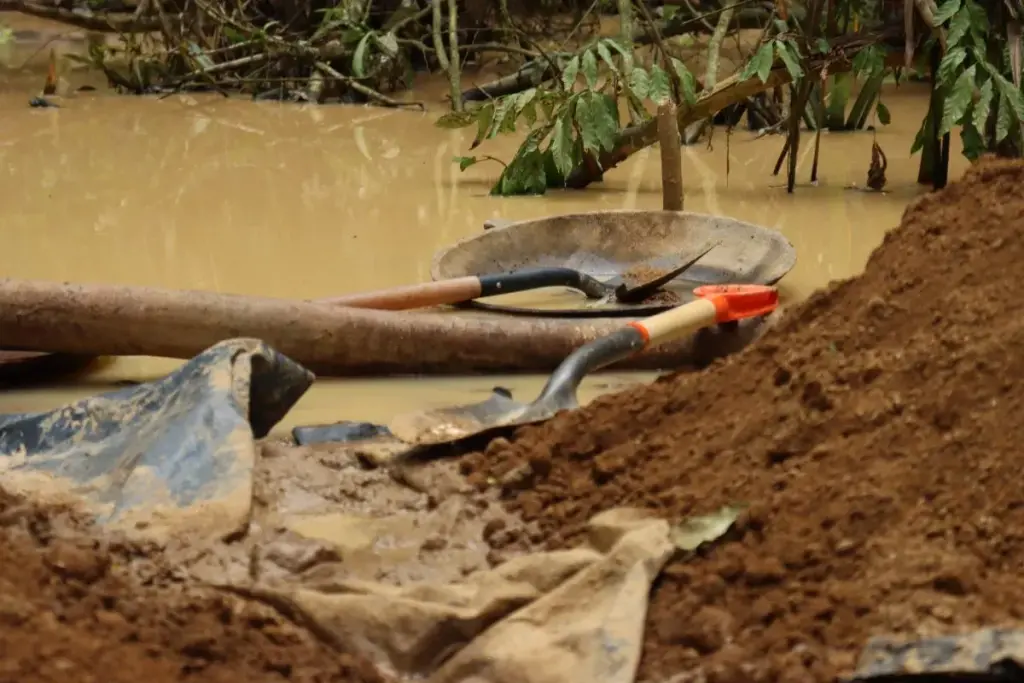Panamanian border authorities report a dramatic shift in criminal activity within the ecologically sensitive Darien province. The National Border Service, known as Senafront, is now confronting an explosion of illegal gold mining operations it says are directly linked to the powerful Gulf Clan cartel. This criminal pivot follows Panama’s successful 2024 closure of irregular migration routes that had previously generated millions in revenue for armed groups.
Between 2024 and the present day, Senafront and the Ministry of Environment have dismantled at least 45 illegal mining camps. These clandestine operations are primarily concentrated at the headwaters of vital rivers like the Tuira and the Mangle. Security forces have apprehended 31 individuals, a mix of Colombian and Panamanian nationals, in connection with these environmentally destructive sites.
“The Gulf Clan has diversified its activities in the border area following the decline of the migrant trafficking business,” a Ministry of Security report stated, referencing the period between 2020 and 2023 when human movement was at its peak. [Translated from Spanish]
The crackdown, part of a broader regional effort, highlights how transnational crime syndicates quickly adapt to law enforcement pressures. With a key income stream severed, these groups have turned to plundering natural resources, creating a new and complex security and environmental crisis.

From Migrant Trafficking to Environmental Plunder
The current situation has its roots in a major policy shift last year. Panama shut down three irregular crossings used daily by hundreds, sometimes thousands, of migrants traversing the treacherous Darien Gap. Authorities installed a “perimeter barrier” in the dense jungle region bordering Colombia. This action successfully reduced illegal migration but also cut off a lucrative cash flow for the criminal networks controlling the movement.
National and international estimates indicate nearly one million people crossed through the Darien between 2020 and 2024. The Gulf Clan cartel charged each migrant between 80 and 100 dollars for passage to the Panamanian border. The loss of this multi-million dollar enterprise created a powerful financial incentive for the group to seek alternative revenue sources.
Security analysts had long warned that suppressing one criminal activity without addressing the underlying structures would simply lead to displacement. The rapid proliferation of illegal mining camps confirms those fears. These new operations require significant coordination and investment, indicating a strategic decision by the Gulf Clan to reallocate its resources and personnel.
A Coordinated Binational Response
Panamanian forces are not acting alone. A landmark binational operation on January 31, 2025, featured collaboration between Senafront and the Colombian Army. The joint mission, dubbed Operation Elias, resulted in the dismantling of 15 structures containing gold extraction machinery along the border rivers.
That operation led to the apprehension of seven Panamanian citizens, all from indigenous communities, and three Colombians. It provided concrete evidence of the Gulf Clan’s direct involvement in orchestrating these mining ventures. Investigators believe the illegally mined gold is smuggled into Colombia, with profits laundered through a complex web of shell companies and businesses.
“Colombians recruit Panamanian indigenous people for jungle mobilization, guard duties, and equipment operation,” a Ministry of Security report revealed, outlining the operational structure of the mining camps. [Translated from Spanish]
This recruitment tactic exploits local knowledge and provides a layer of deniability for the international cartel leaders. It also creates internal social tensions within remote communities where economic opportunities are severely limited.
An Ecological and Public Health Catastrophe
The environmental impact of this illegal mining surge is devastating. The use of mercury to separate gold from sediment is standard practice in these illicit camps. This highly toxic metal then transforms into methylmercury, a potent neurotoxin that bioaccumulates in the aquatic food chain.
The alarm is most acute for the Emberá and Wounaan indigenous communities. Their subsistence depends directly on the rivers for fishing and drinking water. The Ministry of Environment has labeled chronic exposure to this heavy metal an existential threat to these populations. Their primary source of protein is now contaminated, posing severe risks to children’s neurological development and causing serious disorders in adults, including muscle weakness and cognitive damage.
Authorities are urgently calling on residents to report any illegal activity to help protect the Darien National Park. This ecosystem is a UNESCO World Heritage site, and its biodiversity and capacity to mitigate climate change are being severely compromised by the destructive mining. The damage extends far beyond the immediate mining sites, poisoning watersheds that sustain entire regions.
A Regional Criminal Enterprise
Panama’s struggle is part of a larger regional pattern. A recent Interpol report specifically names Panama, alongside Bolivia, Colombia, and Peru, as the areas most affected by illegal mining. The document states that rising global gold demand acts as a major pull factor for criminals throughout Latin America.
The Interpol analysis explains that illegal mining generates no tax revenue or formal employment. Instead, it is an activity often controlled by transnational organized crime, serving as a funding source for narcotrafficking, smuggling, and human trafficking. The profits are immense, and the environmental and social costs are externalized, creating a perfect storm for criminal enterprise.
This problem is not confined to the remote Darien province. In March 2025, the National Police and the Ministry of Environment executed Operation Caribe Verde within the Chagres National Park. This critical area lies within the Panama Canal watershed. The operation dismantled 22 camps dedicated to illegal mining located between the Cuango and Culebra rivers. Additional illegal posts have been found in the Rita river in Sabanitas, Colon, in Soberania National Park, and in the Chepo area.
Panamanian law sanctions crimes against natural resources with prison sentences ranging from three to six years. These penalties can increase to up to nine years depending on the severity of the environmental damage. Enforcement, however, remains a monumental challenge in the vast, roadless wilderness that characterizes much of the country’s interior. The government’s current campaign represents a significant escalation in the fight to protect its natural heritage from a formidable and adaptive criminal adversary.



